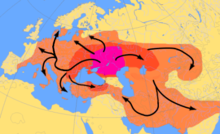Protoindoeuropaei
grex ethnicus praehistoriae
Protoindoeuropaei[1] gregem ethnolinguisticum Eurasiae fuisse censentur, lingua Protoindoeuropaea loquentem, quae secundum methodum refectionis verborum sicut parens omnium sermonum Indoeuropaeorum coniicitur.

Res quae de eis scimus sunt quod concludere potest de illa refectio verborum[2] et nonnullae res inventae ab archaeologia et archaeogenetica[3][4]. Verisimile est Protoindoeuropaeos fere in millennio 4 ante aer. vulg. vixisse, ad finem Neolithici. Plurimi eruditorum terram eorum in hodierna Ucraina et Russia australi fuisse censeant.
Notae
recensere- ↑ Haec appellatio a Vicipaediano e lingua indigena in sermonem Latinum conversa est. Extra Vicipaediam huius locutionis testificatio vix inveniri potest.
- ↑ Ioannes Holm, A possible Homeland of the Indo-European Languages.
- ↑ Volfgangus Haak et al., Massive migration from the steppe was a source for Indo-European languages in Europe.
- ↑ Gulielmus Chang, Chundra Cathcart, David Hall et Andreas Garrett, Ancestry-constrained phylogenetic analysis supports the Indo-European steppe hypothesis
Bibliographia
recensere- Will Chang, Chundra Cathcart, David Hall, Andrew Garrett, "Ancestry-constrained phylogenetic analysis supports the Indo-European steppe hypothesis" in Language vol. 91 (2015) pp. 194–244
- Romain Garnier, Laurent Sagart, Benoît Sagot, "Milk and the Indo-Europeans" (2017)
- Wolfgang Haak et al., "Massive migration from the steppe was a source for Indo-European languages in Europe" in Nature vol. 522 (2015) pp. 207–211
- C. C. Uhlenbeck, "Waar werd de Indogermaansche stamtaal gesproken?" in Tijdschrift voor Nederlandsche Taal- en Letterkunde vol. 14 (1895) pp. 69–74
- C. C. Uhlenbeck, "De voorgeschiedenis der Indogermaansche volken" in Taal en Letteren vol. 7 (1897) pp. 1–25